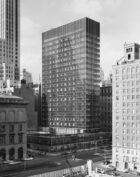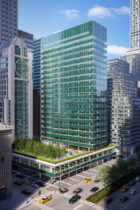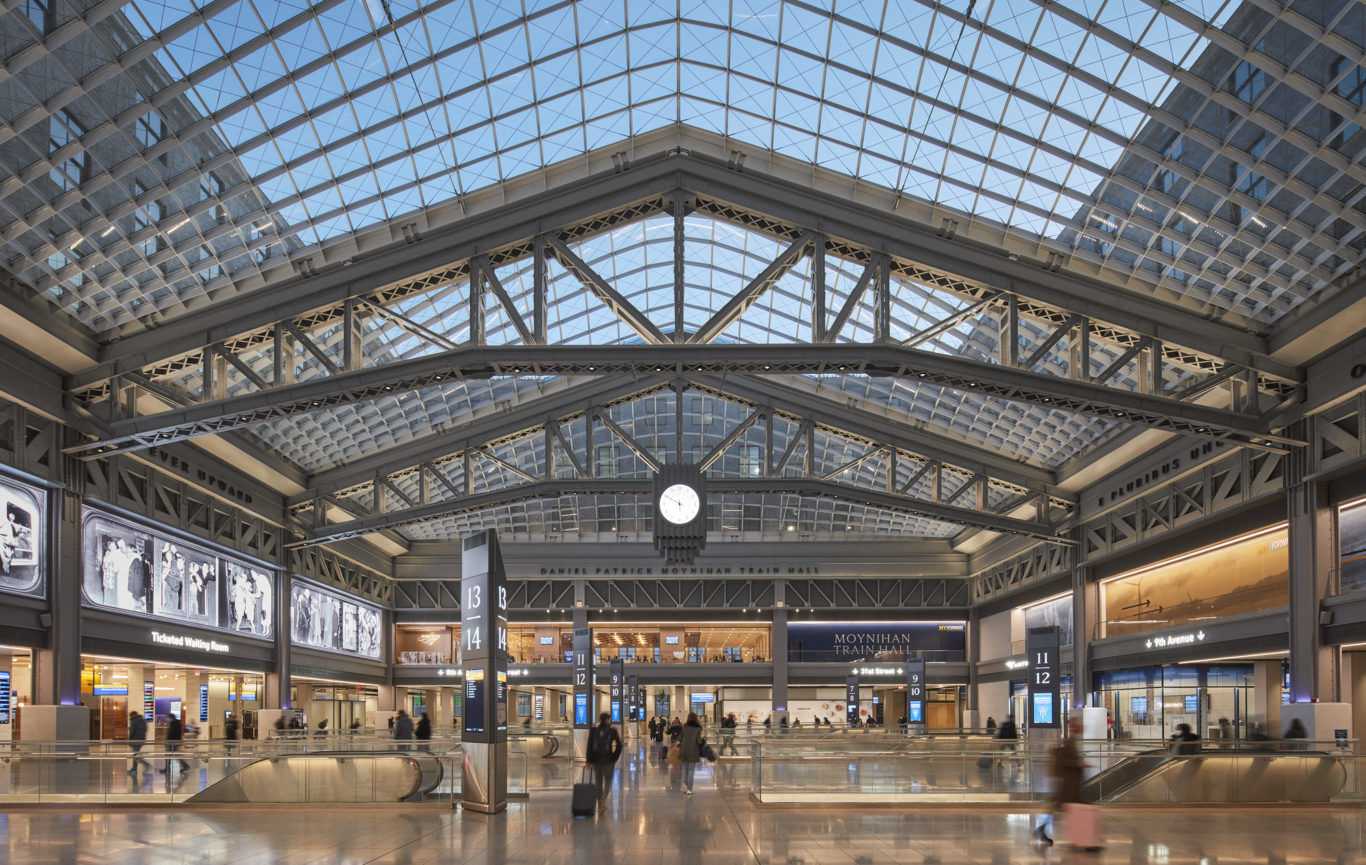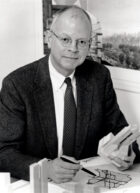New York City’s aging office buildings from the 1950s and 60s pose a conundrum. Falling short of today’s sustainability standards and in dire need of renovations, many of these buildings have seen increasing vacancy rates in the wake of the pandemic, to the point of becoming financially unviable for building owners.
In stark contrast, the commercial real estate market has seen a faster recovery in newer, premium office leases. Citing the effects of this “flight to quality,” a study published by commercial real estate brokerage Cushman & Wakefield indicates that more than 20 percent of total office inventory in the U.S.—over one billion square feet—is now considered “competitively obsolete,” meaning those buildings will either need to be upgraded or repurposed.
Unlocking the hidden potential in aging buildings requires imagination and creativity. How can we make them attractive to new tenants, economically viable for owners, and responsive to the city’s climate goals? Frank Mahan, leader of SOM’s adaptive reuse practice, and Nico Kienzl, a director at the environmental design and engineering consultancy Atelier Ten, discuss the enormous potential—and the urgent need—to find solutions for the city’s less-distinguished office buildings.

Frank, what are the goals of adaptive reuse at SOM?
Frank Mahan: It’s relatively unique to have a practice within an architectural office that is focused on adaptive reuse. For us, this includes anything having to do with existing buildings: changing use, repositioning for longevity, or retrofitting for improved energy performance.
Figuring out what to do with our existing buildings is crucial to addressing climate change, and we see it as a unique expertise within architecture, one that requires technical knowledge that is distinct from designing new buildings, as well as regulatory expertise—working with the Department of Buildings or the Landmarks Preservation Commission, for instance, or navigating city and federal policies. And there is conceptual expertise, a way of approaching these projects with a great degree of flexibility with regard to the outcome. The very existence of this practice says a lot about our firm’s values. We believe in being stewards of our built environment—utilizing our expertise to ensure the vibrancy of our communities and the health of our planet.
Nico, tell us about your role and how you connected with SOM.
Nico Kienzl: I’m a director with Atelier Ten in New York City. Our firm started as a mechanical engineering firm in the UK but has expanded our expertise in sustainability by filling the gap between architects and engineers. We have expanded our focus on things like environmental design, climate impact, thermal comfort, lighting design, and wellness.
I actually connected with SOM before I joined Atelier Ten. I was out of graduate school, looking for my first job, and I interviewed for a position at SOM. I’ve been in touch with the firm for a long time and we’ve done many, many projects together in the 20 years since.
Some of your recent work is focused on retrofitting midcentury commercial buildings. What are the unique challenges and opportunities for this building type?
Frank: Particularly in New York, the midcentury decades—roughly the 1950s through 1970s—represented the largest building boom in the modern era, and therefore the largest investment in embodied carbon in the built environment. These buildings employed technologies that were innovative at the time, but which today have often proven energy-inefficient and in need of retrofit.
Some of these are landmarked buildings, such as our own Lever House. These will always be well cared for because of their cultural and architectural significance. In fact, the current stewards of Lever House, WatermanClark and Brookfield Properties, are investing in a comprehensive renovation and modernization of the property and have brought on SOM to lead the project. But there are many, many more buildings that are not necessarily culturally significant; these are the ones which we—architects and engineers—must work with owners to figure out what to do with.


Nico: Just as a qualifier, in New York, there were two big waves: the first wave was residential construction post-World War I. The big wave in commercial construction happened in the 50s and 60s, and that’s the building stock that is now in dire need of intervention.
It’s also important to note that elements of a building age and get replaced at different rates. Lighting systems often get updated every ten years, because that’s when the lease turns over and there’s a new interior fit-out. The mechanical system changes every 25 to 30 years, typically due to technology updates. And the building enclosure and more substantial components change maybe every 50 years, so many of these buildings haven’t even had that yet.
We’re now at this point where a lot of midcentury buildings had their last major upgrade in the 80s, and at that point people weren’t really thinking about energy in the same way that we are now. Some of those interventions actually made things worse, because they introduced heavy air conditioning. This was really the first generation of buildings that had air conditioning; before that, people were used to different comfort criteria. Today that equipment from the 80s is now reaching its end-of-life, and the building envelopes need replacement, too. So we have an opportunity to rethink this building stock in a holistic way.
Together with advances in technology, I think that design creativity is going to be one of the keys to unlocking the viability of retrofitting, as opposed to tearing these buildings down in the future.
One of the limiting factors for many midcentury buildings is the perception that you’re stuck with a relatively low floor-to-floor height, in part due to retrofits that happened in the 80s, when ceilings were dropped to add more air conditioning. However, with the current technology, we can integrate thinner systems and raise the ceiling back up, without giving up on occupant comfort. That is a very recent shift, and it makes retrofitting a lot of these buildings much more viable than it was 10 or 15 years ago.
SOM’s trajectory aligns with this history. Your firm designed a lot of these buildings in the 50s and 60s. Your heritage is in these buildings. So there’s a deep historic knowledge about why these buildings were designed the way they were, but also how and why we moved on.
Frank: There’s a common misconception when we talk about reusing buildings or retrofitting buildings. What we’re really interested in is saving embodied carbon, and that means, largely, the structure. We can do so many things to improve the building without touching the structure. We can upgrade the envelope, mechanical systems, vertical circulation, and end up with what is—for all intents and purposes—a brand new building.
SOM did this with Citi’s new global headquarters in Tribeca. Citi had two existing buildings, right next to each other, both originally constructed in the 1980s—a 39-story office tower and a 9-story former printing plant. Our client made the bold decision to merge and transform these two buildings into a singular global headquarters, rather than build anew. We did work on the facade, the mechanical systems, and vertical transportation. All the interiors are new. We created an occupiable roof terrace where you previously only had mechanical systems. When you experience the new Citi headquarters, it feels like a brand new building.
Nico and I worked together on a concept for how to create economic value—not just climate value—for an owner of a class-B 1960s office building. We used 63 Madison as a case study, a Midtown office building that has some of the challenges that are typical of the commercial buildings that need retrofitting today. The building has a relatively large footprint, so not a lot of daylight reaches deep into the floor plate. It has very small windows and low ceiling heights.

We took a very aggressive retrofit approach: carving away at the building, taking out floor area, reapportioning it to different areas at the top, creating outdoor terraces. All of these moves were intended to create new value, allowing the owner to lease it at much higher rates in the future. We saved all of the embodied carbon associated with not only the structure, but also the envelope. Together with advances in technology, I think that design creativity is going to be one of the keys to unlocking the viability of retrofitting, as opposed to tearing these buildings down in the future.


Nico: In practice, we find that you cannot make a strong argument for a deep retrofit on the energy or carbon savings alone; you also need to understand the added value for the owner to do something much bigger and much bolder. There’s a beauty to the economics of this approach. Because we’re not rebuilding the entire building, we don’t need to spend all that money on a new structure, or spend the time tearing down the existing building and excavating the site and rebuilding. That opens up other opportunities in terms of where you want to spend money on the project to make it more desirable.
63 Madison shows what is possible today to reimagine commercial buildings with new technologies and with the right design approach. It’s different, of course, from what you would do on a reuse of the Farley Post Office building, which is another project that we’ve done together. There we had a different structure to work with, a different envelope, and we responded to it in a different way.
The important thing is to start conversations with a client before they make the decision to replace the building, to show them what’s possible.

Frank: This requires a totally different way of thinking and expertise. Schedule, timing, logistics, capital plans, how you switch over mechanical systems, where people move during a retrofit—these are conversations that nobody is used to having when they tear down and build new. It’s a new world for so many owners, and it requires dedicated thought and advice from experts.
Nico: Having grown up in Europe, where we’ve dealt with existing buildings in a different context for a long time, I’m always amazed how much of the development mindset here in the U.S. is focused on new-build.
How does policy play a role in this conversation about retrofitting and reuse? New York City has passed significant legislation in recent years which sets targets for building energy performance and is kicking off a new wave of retrofits.
Nico: New York is unique because of its scale. That allowed it to track climate impact data at scale, especially under Mayor Bloomberg, who prioritized this. So, we have a more informed understanding of where energy flows, what the main drivers are, how you start building policy around that, than many other cities.
The most significant change that also happened during the Bloomberg years is that local laws were signed that affect existing building stock. For the first time, existing buildings, constructed to code without major changes, had to report energy data and required recommission every 10 years.
Now, policies are coming into place that have an even deeper impact. The biggest one in New York is Local Law 97, which is starting to levy a penalty on existing buildings if they exceed allowed carbon emissions. The allowed amount will step down over time towards the goal that the city has articulated: an 80 percent reduction in citywide greenhouse gas emissions by 2050.
Frank: It’s great that Local Law 97 is finally addressing operational carbon of existing buildings, but embodied carbon is still a huge blind spot in regulations. For example, consider what has happened since the East Midtown rezoning in 2017, which permitted greater building heights in the area surrounding Grand Central Terminal and along Park Avenue. This kicked off a wave of demolition of older commercial buildings, which are being replaced by new, taller ones. This is the right place to redevelop, for sure—it’s the commercial core of the city and well-served by transit. However, the rezoning has only incentivized new-build and not also redevelopment of existing buildings.
Zoning in New York City supports external planning priorities all the time. The East Midtown rezoning supports transit by requiring owners to rebuild transit stations or entrances. Couldn’t there be a way for zoning to support how we’re addressing climate change by encouraging the retrofit and maintenance of existing buildings, in tandem with new development?

How can we find the right balance between those two strategies?
Nico: I think adaptive reuse will need to become a much bigger proportion of redevelopment, and at a much faster pace. We need a combination of policy levers to penalize owners who don’t upgrade their buildings, as well as incentives to adapt and reuse rather than build new.
Frank: It’s important to remember that we’re not saying we should maintain and retrofit our buildings just because that’s the right thing to do, and it’s going to be painful. We think that this can be economically viable and even attractive for the owner. It’s the right thing to do to fight climate change, but also it’s the right thing to do from a civic perspective. These buildings shouldn’t fall into disrepair; they should be given a new life. All of these things that we’re talking about—preserving cultural legacy, retrofitting to create outdoor spaces and increase access to natural light—all of these things are good for people, too. So this is really a win-win proposition.
Nico: The pandemic has also highlighted the need to transform single-use buildings to make our neighborhoods and cities more resilient. In commercial areas, once all the white-collar workers were working from home, the local retail shriveled and died almost immediately. This gets at bigger questions of what we want out of our cities, and how we could adapt some of our existing single-use buildings to support a more varied mix of uses.
Another point to consider: how can we build in that kind of long-term flexibility for new construction as well? It’s interesting to see that some of the buildings that have the most staying power are old warehouses, spaces that have ample floor-to-ceiling heights and flexible plans that have allowed them to be reused. With so many unknowns in the future, we should be asking bigger questions with every new project.
Frank: Right, and it’s what we talked about earlier, that this is a different way of thinking from start to finish—it’s different for the owners, it’s different for regulators, it’s different for designers, and we’re starting to address it now. This way of thinking will permeate new building design, new zoning and regulations, and the way that building codes are written to allow for changes to egress or fire ratings. These are all things that are very complicated to address now, when we retrofit, because they’re not explicitly addressed in the building code.
Does this lead to a future where adaptive reuse is no longer a specialized practice, but part of the mainstream in architecture?
Nico: I think that adaptive reuse probably still has a place as a specialized practice, because you need a certain know-how about the way buildings were built 20, 50, 100 years ago and why. When you start with an existing building, knowing how you survey it, how to do the forensics, how to deconstruct it—that is very different from starting from a blank slate and designing a new building. But in terms of design philosophy and generating new ideas, I think there’s a rich feedback loop between the two sides of a practice that does both, like SOM.




